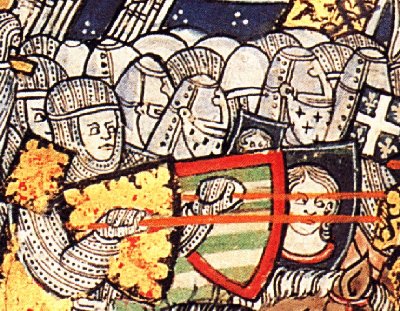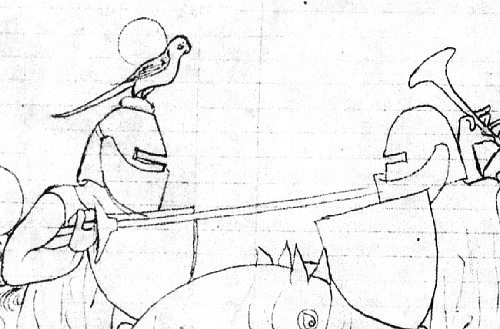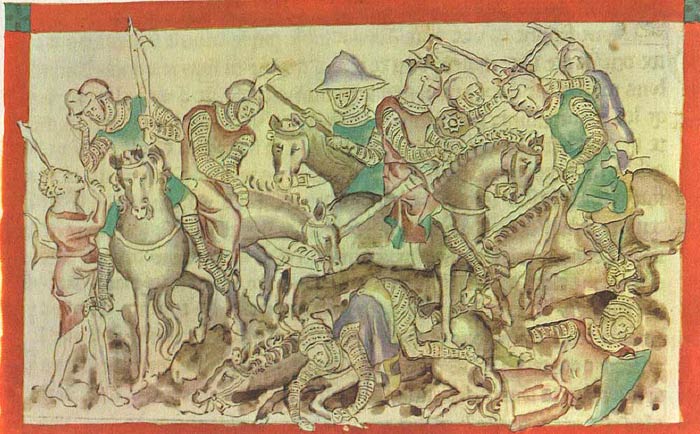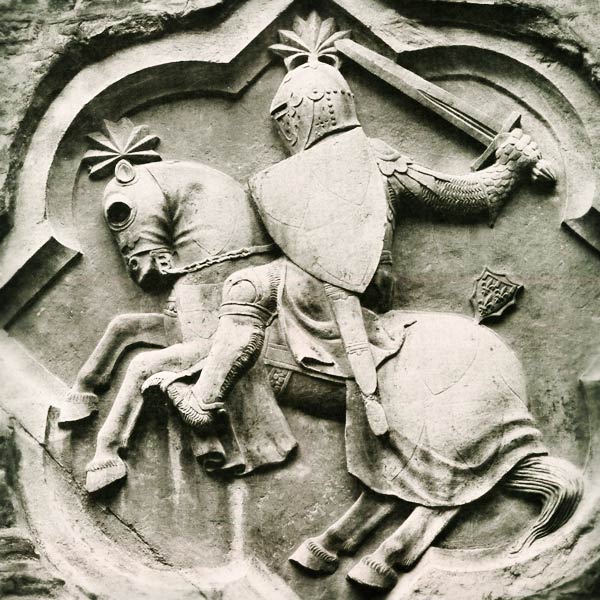| Author |
Message |
|
Greg M
Location: Alberta Joined: 13 Aug 2011
Posts: 7
|
 Posted: Sat 13 Aug, 2011 9:07 am Post subject: 14th Century Sugarloaf Question Posted: Sat 13 Aug, 2011 9:07 am Post subject: 14th Century Sugarloaf Question |
 |
|
Hello,
I am in the process of putting together a 14th century harness. One of the big issues is the helmet. The 14th century was a big transition period for armor, and helmets. I really like the great helms, but visibility is poor during combat. So having a basinet with a visor i.e Klapvisor, Houndskull etc. is more optimal, so you can raise the visor for sword combat but lower it for polearm. I came across this Sugarloaf by steel legacy but I have never scene any historical references to something like it. I am very far from an expert, so I thought I'd post the question. Does this helmet have any 14 century historical accuracy?
http://sl-armours.com/en/gallery-of-medieval-...ntury.html
|
|
  |
 |
|
Derek Estabrook
|
 Posted: Sat 13 Aug, 2011 2:09 pm Post subject: Posted: Sat 13 Aug, 2011 2:09 pm Post subject: |
 |
|
|
The "sugarloaf" style of helm IS a form of greathelm and it is a very dated style being very early to mid 14th c (1340). Forgive me if I'm wrong, but I don't think I've ever seen one either in illustration or archaeology with a visor and really doing so would turn it more into a bascinet anyhow. A sugarloaf helm will still have the visibility issues you have with other form of greathelm. I would either have the slits done custom in a more acceptable way to your needs or if your needs preempt the design I would go with a visored bascinet. Keep in mind also that there are trade offs with using a visored helm as well, hence the reason a lot of combatants outside the tournament circle left them off entirely. The restricted vision and breathing factors of a greathelm of any form which can only be mitigated to a point with design is balanced by (especially in later stages) being very protective and offering good coverage.Also, it was a much favored tactic to win a combat when one is facing a heavily armoured opponent by using ones visor against them. A visor will always be a potential liability, but one that must be weighed into account as well as the opposite spectrum of visibility, breathing, etc. for the greathelm. For a modern man who is often more concerned about comfort and appearance, the choices are often made on different factors and in a different connotation. My advise is to wear the different designs and see which works best for you when wearing each for an extended period and possibly in limited combat scenarios. Also, keep in mind that there is no one way of doing the slits in a greathelm, but there is a practical limitation. If you end up with big bug eye occulars it will hardly do its job in protecting your eyes. Just because the smith made one greathelm a certain way and the vision is terrible for you, its possible to you can find a design that mitigates the visibility problem enough to be a useful design for you. I wouldn't be hasty in writing off the greathelm styles including the sugarloaf, yet.
|
|
  |
 |
|
Derek Estabrook
|
 Posted: Sat 13 Aug, 2011 2:19 pm Post subject: Posted: Sat 13 Aug, 2011 2:19 pm Post subject: |
 |
|
Oh, one more thing.
While I have not seen a visor on a sugarloaf, I have seen moveable bevors on the them. Perhaps the smith mistook this for a visor or just chose to value what they thought was cool over historical research, either way personally I would not buy the helm pictured and would not allow it to be used in my living history group either. It would be one of those "Terribly sorry, hate to tell you it can't be used, but I'd be glad to help you find one or make one that works", scenario.
|
|
  |
 |
|
Greg M
Location: Alberta Joined: 13 Aug 2011
Posts: 7
|
 Posted: Sat 13 Aug, 2011 2:51 pm Post subject: Posted: Sat 13 Aug, 2011 2:51 pm Post subject: |
 |
|
|
Thank you very much for you response. I've always like the look of bevors and visored salet, but veered away from them because I believed them to be more 15th C. and later. Did they use bevors in the 14th?
|
|
  |
 |
|
Derek Estabrook
|
 Posted: Sat 13 Aug, 2011 4:25 pm Post subject: Posted: Sat 13 Aug, 2011 4:25 pm Post subject: |
 |
|
Heres a couple of pics of a hinged bevor if you want to use it for a great helm.
The bevor was present in the 14th c, however I do not think it was very commonly used in most of Europe until at least the late 14th-early 15th century. I would also be careful that you use examples whether from illustration or artifact from the time period you wish to portray.
 Attachment: 58.7 KB Attachment: 58.7 KB

 Attachment: 38.17 KB Attachment: 38.17 KB

|
|
  |
 |
Randall Moffett

|
 Posted: Sun 14 Aug, 2011 7:23 am Post subject: Posted: Sun 14 Aug, 2011 7:23 am Post subject: |
 |
|
I think what you are seeing in the 14th century is simply a major shift in helmet design.
Around 1300 you have men with small rounded and pointed helmets that are little more than skulls, kettle helmets and great helms.
Now the most common theory of helmet development is the small skull type helmets turn into bascinets. I do not believe this is entirely true. I think they are both moving toward bascinetness.
Early on say in the Queen Mary Psalter you are seeing great helms with bascinet tops and visors. So to me these are indeed Sugarloafs but only because I qualify any mulitplate constructed helmet covering the entire head like this. In the end you can have a bascinet of one piece and a one piece visor and a sugarloaf/great helm that is nearly identical except it has maybe 1-3 more plates in its make up. So in reality the helmets are of similar design and shape but different construction.
My advice is to look up the Queen Mary Psalter , Holkham Bible, Taymouth Hours (Thomspon Yates 13) or other illustrations from the period. Effigies are good for getting an idea of the right look as well.
There are way more variants of helmet types in use during 1300-1360 than most would believe so take a look around and see what you like the best.
RPM
|
|
  |
 |
|
Greg M
Location: Alberta Joined: 13 Aug 2011
Posts: 7
|
 Posted: Sun 14 Aug, 2011 8:44 am Post subject: Posted: Sun 14 Aug, 2011 8:44 am Post subject: |
 |
|
Thank you for the tip, just a quick look and I found and image with two examples of visored 'great helms'. The two with crowns clearly depict visored helms while the one on the back right could be visored or may just be a 'normal' great helm.

|
|
  |
 |
Chad Arnow
myArmoury Team


|
 Posted: Sun 14 Aug, 2011 10:12 am Post subject: Posted: Sun 14 Aug, 2011 10:12 am Post subject: |
 |
|
From our article Spotlight: The Great Helm:
| Quote: | | In the early parts of the 14th century, we see a curious development in period art: great helms with moveable, removable, and/or pivoting visors. One of the clearest depictions of the visored great helm comes from a carving once located at the Bargello Palace in Florence [see image below]. While clearly foreshadowing later helms, these helms do not appear to have been widely popular. Indeed, no known examples of this form survive to the present day. |


ChadA
http://chadarnow.com/
|
|
    |
 |
|
Greg M
Location: Alberta Joined: 13 Aug 2011
Posts: 7
|
 Posted: Sun 14 Aug, 2011 12:04 pm Post subject: Posted: Sun 14 Aug, 2011 12:04 pm Post subject: |
 |
|
|
I noticed that carving when I was reading the Great Helm article but I'm not sure where and when it came from. Do you know?
|
|
  |
 |
Chad Arnow
myArmoury Team


|
 Posted: Sun 14 Aug, 2011 12:16 pm Post subject: Posted: Sun 14 Aug, 2011 12:16 pm Post subject: |
 |
|
| Greg M wrote: | | I noticed that carving when I was reading the Great Helm article but I'm not sure where and when it came from. Do you know? |
It supposedly dates to 1320-1325. It was once in the courtyard of the Bargello Palace in Florence. I'm not sure where it is now; the book I found it in has no more info than what I've given here. 

ChadA
http://chadarnow.com/
|
|
    |
 |
Iagoba Ferreira

|
 Posted: Mon 15 Aug, 2011 5:56 am Post subject: Posted: Mon 15 Aug, 2011 5:56 am Post subject: |
 |
|

That one is from Artajona, Navarra, and dated 1335 by an inscription (just under the figure). Visored sugar loaf or early bascinet, the painting shows clearly with the visor opened, among other interesting details...
A nice replica of this style of helmet has been done recently by Marshal Historical.
|
|
  |
 |
|
|

